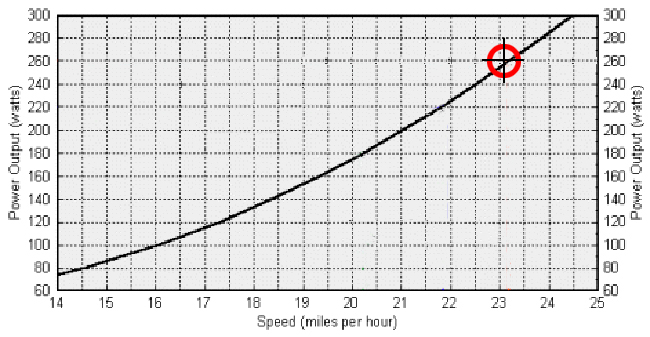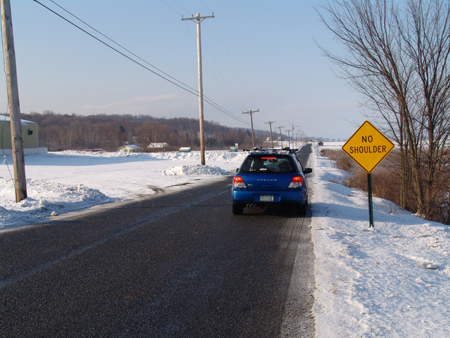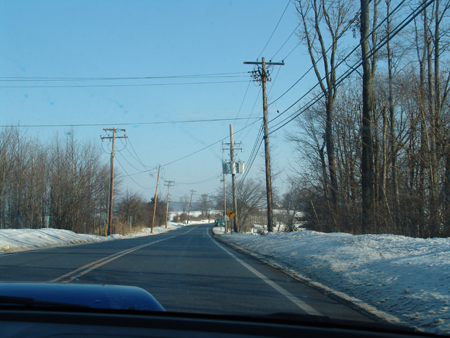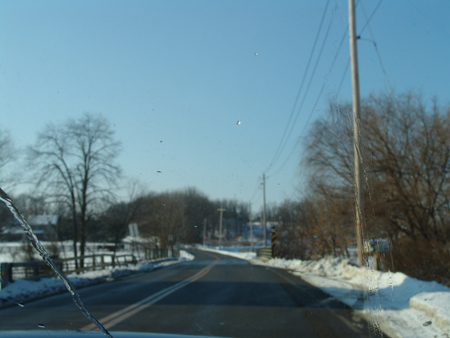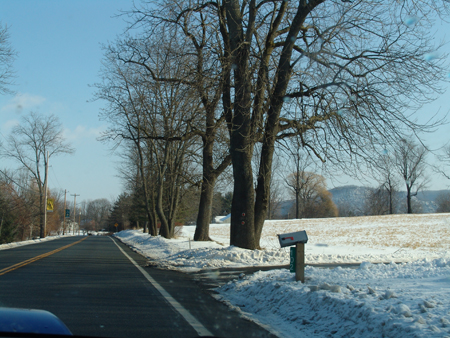|
[
Hump
|
Timeline |
Clearwater Bridge |
Suncoast Trail |
Fort De Soto Park |
Pinellas Trail |
Watts Compared
] THE WIDDERS HUMP
The goal for 2011 is a 23+ mph average for The Black Widow over the 34.2 mile course, otherwise known as The Hump. Doing this will require a time of just under 1:29:13.04 line to line. Therefore, Mary will be doing 8 four-mile splits at 10:26.08 each, plus a final split of two and two-tenths miles at 05:44.34. One of those splits will have to be one hundredth of a second under the stated goal, but who's counting? The process is being chronicled in the training log Timeline which includes links to related articles, and the results are being rolled up into the book: Cycling Performance Simplified. In any case, all of our Florida rides this winter are precision workouts designed specifically to meet the goal. Much of it is top secret, proprietary, and privileged information, but there is also plenty that can be published. As of 01/01/09 all preliminary baseline results have been very promising. For all you newbies, The Widder will be 55 years old the summer of 2009, so you are going to be extra upset with yourself for not keeping up... which you won't. This page is a work in progress (in fact so are all of the Widder's Hump pages), so check back to watch as details are added. The Hump is a long standing (every Saturday morning) extremely competitive local club ride that may be approached in at least three different ways: 1) The typical method is to go out with the group and treat it like a road race. All the elements of race tactic, subterfuge, and generally fucking with each other in hopes of throwing the other riders off their game occur in a no holds barred full force forward environment. The competition is so fierce that one may often find among the riders several nationally ranked road racers who are taking the day off while keeping their competitive edge by matching themselves against riders of equal ability. 2) Another method (which is very rare), is to basically Time Trial the course. You may use riders who happen past (or whom you catch) as draft monkeys to the degree they are useful but otherwise keep to your own game plan in an attempt to complete a challenging course of consequential length in a time that is impressive and proves riding prowess. 3) A third approach (the one generally taken by SlingShot) is to go out with the group, try to take every hill, finally get dropped for the pure stupidity of it, and make note of whether you made it further (or less far) than ever before. For those who are new to cycling sport, or The Hump, or both, a little perspective is in order. The course includes enough climbing to satisfy almost any rider, especially considering the speed on the climbs required by the level of competition. A standard gauge of the success of any given Saturday's ride, is to observe the average speed in mph for any specific sub-group or individual. That also allows people to keep track of their performance over the length of the ride without having to think about splits, times, cutting turns just right, etc. As of this writing there has never been a reliable report of a group finishing over 25 mph, but there are routine reports of those who are off the front of the front group finishing solidly over 24 mph. To put that in context, that is very close to a Tour de France stage average but about 100 miles shorter and without the little matter of the Alps. However, like I mentioned, there is still plenty of climbing given the circumstances. Most groups behind that little group of elitist front runners rarely report finishing over 23 mph, so that makes the figure a respectable goal. One can take the attitude that a 23+ finish requires a group working together, and throw oneself into the fray hoping to stay with a bunch of riders who are purposely trying to cause each other harm—getting in each other's way and trying to sucker each other into blowing up and getting shelled out the back. In contrast, one can realize the fact that even 25+ would not be an earth shattering performance anywhere near the horizon of human potential, so a 23+ is something well within the grasp of a strong and thoughtful rider (on their own), who pays careful attention to their performance. Of course this assumes the rider knows their performance very well and has spent the appropriate time perfecting the skill of controlling pace while rationally improving their performance capacity over time... over a rather long time. Obviously what has just been described is an accomplished rider whose completion of this goal will clearly place them among the strongest of Hump riders, not to mention likely place them very near the finish (at the time of the finish,) despite having spent a lot of their ride sometimes behind, sometimes in front, and generally all around other riders who will be dashing up hills, coasting on the downhills, waiting for weaker riders to catch up in order to beat them up again, that is to say all the standard Hump shenanigans we all so dearly love. Enough writing for today. I'm going out for a ride. Come back for more soon. In the meantime, notes on The Widder's progress are found by following the links near the top of this page. They look like this: [
Hump
|
Timeline |
Clearwater Bridge |
Suncoast Trail |
Fort De Soto Park |
Pinellas Trail |
Watts Compared
] As of 07/23/08 all this material is being summarized and rolled up into the book: Cycling Performance Simplified
01/04/08: Mary succeeded holding 230 watts for a 2.2 mile interval along Gulf Boulevard after a warm-up of six miles at 80 watts and 2 wind sprints over the Clearwater bridge. The 230 watts was our preliminary guesstimate using data compiled from her Computrainer results during December of 2007. 01/05/08: 36 miles of various intervals in order to repeat preliminary results showing 230 watts could provide a 22+ average, and to review correct spin up and gear changing procedures while holding correct wattage on uphills. 01/05/08: 7 intervals in Fort De Soto park for further confirmation that 230 watts would provide 22+ miles in various situations. Afterwards a sprint over the bridge to 479 watts. On returning home, found numbers in table below that confirm our ballpark figures. No need to search for formulas. The Computrainer and web have done their job. Preliminary rule of thumb observations confirmed by article in Peak Performance Newsletter (number 234):
These figures discount improved performance through aero bars, etc so provide an excellent basis for further observations of Mary's current performance plus a starting point for workout goals. The 22+ was relatively easy, the 23+ will require some work. 01/10/08: Blah, blah, quack, quack... between last log entry of 01/05/08 and today more work done on establishing the baseline plus Mary's understanding of Watts = Watts. Today in Fort De Soto we did 9 intervals at 300 Watts just to test the upper limit. Very good results. The chart for Watts vs. Mph (above) continues to be confirmed. A couple days ago Mary held 23+ going into a head-wind. Results point to 300 Watts as now being our target workout for hard days. The last interval was shorter and harder than the rest in order to begin modeling the The Widders Hump. Then, for fun, we tested a 240 Watt longer interval just to see. Mary was inspired when she realized how easy it had become. Afterwards, we did a dessert sprint on the bridge and called it quits, spinning an easy 10 miles for cool down. Future workouts will mix and match using a combination of long easy rides, variations on the intervals (pyramid's, fartlek, etc), and sprint work of course. More specific notes regarding today and previous days are found in Mary's personal hand-written training log. Plus there is even more specific and detailed information tucked away safe inside of SlingShot's head. Hopefully we can get everybody back in NY to stop reading anything related to cycling performance. That will be to our advantage. Anybody caught reading or complaining about our own workout schedule will get treated like Toe Clip. 01/11/08: Ushered Widder through an easy 100 watts to Clearwater Bridge and back. Practice standing on hill while keeping watts low (under 200) and riding with smooth power for balance. On the way home noted slow recovery after bridge and established a better system for quick recovery after higher watts. It was a recovery ride. 01/12/08: Total rest day, no biking. It didn't really feel like a rest day, because access to the ARC server went down. Spent the day researching alternative co-location services, but the current ISP finally sent an explanation and apology, so they are forgiven. 01/13/08: Baseline assault on the Fort De Soto course. Mary held 230 watts for 8+ minutes, then just bobbled down, narrowly missing achieving her first 4-mile split time for the Widder's Hump. Three weeks ago she could do no more than 30 seconds at that wattage. SlingShot is a genius. It's amazing what can be accomplished merely through correct position. The effect of correct intervals seems almost a bonus. Then we did 5 or 6 more intervals at the same intensity while fine tuning communications regarding starting, ending, and reporting interval status. The better we are at that, the more finely tuned the data will be. When I told Mary to tell me when she was "Off" on the first interval, she thought I meant that I was going to start pulling (since our mph average was so high, and I have a history), so she futzed around trying to get back up to wattage for about a half mile before she told me. Therefore, I missed stopping the watch at the exact moment that she blew. Later, after Mary's heart rate began to spike during intervals, we backed off, called it quits, and began a recovery spin back down to 105 HR in order to take one final dessert attempt at 300+ watts for a shorter interval. Unexpectedly, two cyclists in their drops (and working) passed us just as Mary's HR got back down to 127, so I said, "Want them?" "Sure!" "Ok, forget the recovery, spin up to 300 and see what happens." We dusted them, then allowed them to catch us and did it again before we pulled into our easy-spin review-parking-lot by the water. Those two other riders were obviously in their mid 30's, and training for tri-athlons. It is probably best for their self esteem that they didn't know how old we are. There is also the possibility that the front rider (from the look on their face) was on their own precision workout, so they deserve kudos for hanging with the program and not giving chase. Otherwise, Mary found she can spin a 300+ wattage much easier if there's a target involved. That will become one of her personal mantras to meditate on while riding—how to trigger herself in the same way, without needing a butt to chase. Today's decision: Pace intervals to be set at 230+ for 5 minutes, strength intervals will be 300+ for 1 minute, recovery on bridges will be to coast after regaining speed over top—until we determine what is the highest wattage Mary can drop to and still recover quickly. Spirnt intervals are currently only to around 469, because Mary hasn't finished making the transition from the stationary cycle which takes away the balance requirement. We may be spending more time in Fort De Soto than we planned, due to the grand benefit of having a 21 mile circuit with hardly a break for cars entering the roadway. Of course, there were numerous other decisions and observations, but those are filed away in Mary's diary and SlingShot's head. The only thing more worthless than talking about riding (when you can actually be doing it), is writing about riding. Tomorrow's Plan: An easy 50+ loop out to Fort De Soto and back with nothing over 200 watts... unless a car chases us up a bridge.
Baker, Arnie M.D. 1997 <1996>. "Smart Cycling." Fireside. 1st ed. New York: Simon & Schuster, Inc. ISBN: ISBN: 0-684-82243-1 Burke, Ed. 1995. "Serious cycling." Champaign, IL: Human Kinetics. ISBN: 087322759X Burke, Edmund R., PhD. 1998. "Precision Heart Rate Training: for maximum fitness and performance." Champaign, IL: Human Kinetics. ISBN: 0-088011-770-2 Friel, Joe. 1996. "The cyclist's training bible : a complete training guide for the competitive road cyclist." 1st ed. Boulder, Colo.: VeloPress. ISBN: 1884737218 (pbk.) Kleiner, Susan M. 1998. "Power Eating: build muscle, gain energy, lose fat." Champaign, Illinois: Human Kinetics. ISBN: ISBN: 0-88011-702-8 LeMond, Greg, and Kent Gordis. 1990 [1987]. "Greg LeMond's Complete Book of Bicycling." 2nd ed. New York: Perigee Books. ISBN: 0-399-51594-1 Phinney, Davis, and Connie Carpenter. 1992. "Training for Cycling: the ultimate guide to improved performance." New York: Berkley Publishing Group. ISBN: 0-399-51731-6 Rafoth, Richard. 1993. "Bicycling fuel : nutrition for bicycle riders." 3rd, rev. & expanded ed. San Francisco: Bicycle Books. ISBN: 0933201540 (pbk.) Tortora, Gerard J. 1997. "Introduction to the Human Body: the essentials of anatomy and physiology." 4th ed. Menlo Park, CA: Addison Wesley Longman, Inc. ISBN: 0-673--98222-X
this page last updated:
01/17/2016 01:06:15 PM |
